Back at NOVA Geoblog, I spent a portion of September and October 2009 reviewing the geological wonders I witnessed as part of a GSA field forum in the Owens Valley of California. However, I got distracted by other things, and never finished the series.
I’d like to pick up on that today, looking at a feature which is a typical part of mountain belts like the Mesozoic-aged Sierra Nevada magmatic arc. Here, we will look at a small shear zone exposed in the edge of the Sierra Nevada batholith, in the eastern Sierras, where they meet the Owens Valley, west of Bishop and north of the Tungsten Hills.
Let’s start off with a photo of the area: this is looking to the southeast, with the Sierras to the right, and the Tungsten Hills in the middle distance, and the White Mountain range beyond that. Simon Kattenhorn (blue t-shirt) provides a sense of scale, as do the vehicles parked at the more distant hairpin turn.
You can see those two hairpin turns in the road in this Google Map:
So you can see both in the Google Map and in the first photo that there is a prominent ridge poking up from the hillside there. (It’s the dark green stripe trending ~095° on the map.) From where the cars were parked, this looked like a dike, perhaps of granite, that was weathering out in positive relief. Several of us decided to climb up there and check it out. I’m glad we did, for it turns out to be a positively-weathered shear zone.
Here’s a decent shot that shows well the undeformed granite (bottom third) and the highly-foliated shear zone which cuts across it and deforms it to various degrees (upper two-thirds):
Shear zones are the deep, hot, ductile equivalent of faults. They were first described in the Scottish Hebrides in 1970 by John Ramsay and R.H. Graham1. The idea is that two big blocks of rock move relative to one another, and if conditions are sufficiently high-temperature and high-pressure, in between will develop a zone of smooshed and squished rocks. The textural patterns that result are called a deformational “fabric,” and it is that fabric that calls our attention to the shear zone. You can see some of the more-deformed areas and the less-deformed areas in this photo:
The photo above also shows a top-to-the-left sense of shear, with the bands of dark minerals “tipping over” to the left.
Why this particular shear zone was weathered out in positive relief (standing up above the surrounding hillside) is unknown to me, but I guess that it may have to do with induration: the phenomenon that sometimes faulting or shearing makes rocks harder than they were pre-deformation.
Anyhow, let’s take a look at the various varieties of fabrics that this rock demonstrates. The shear zone cuts through granite, and here’s a relatively undeformed (~equigranular) exposure of the granite:
Small shear band running through the granite, again exhibiting the asymmetric fabric that suggests top-to-the-left kinematics.
A more pervasively-deformed sample, showcasing several decent augen (hard chunks, in this case of feldspar, that the foliation wraps around):
Nicely-developed S-C fabric, again with top-to-the-left shear sense:
Annotated version of the same photo, highlighting the orientation of the S- and C-foliation surfaces. S-C fabrics are typical of ductile deformation in transpressional shear zones…
Another sample, more pervasively deformed, showing smaller grain size (mylonitization):
Ditto, and with a more-fully-developed transposition foliation:
Lastly, here’s the same face that I annotated above, rotated 90°, which to me brings a different sense of perspective to the outcrop:
What really jumps out at my eye about this outcrop is the more-deformed (highly-foliated) and less-deformed (more-equigranular) domains. This is typical of my experience with shear zones: strain tends to be localized in certain bands, with other areas in the same shear zone being markedly less deformed (an old example from the old blog). This makes it tricky to accurately measure the amount of strain the rock has experienced, because no single square inch of this outcrop surface is “typical” of the overall strain in the shear zone.
To learn more about rock fabrics in shear zones, check out this site.
____________________________________________
1: Ramsay, J.G., and Graham, R.H., 1970. Strain variation in shear belts. Canadian Journal of Earth Sciences 7, 786-813.

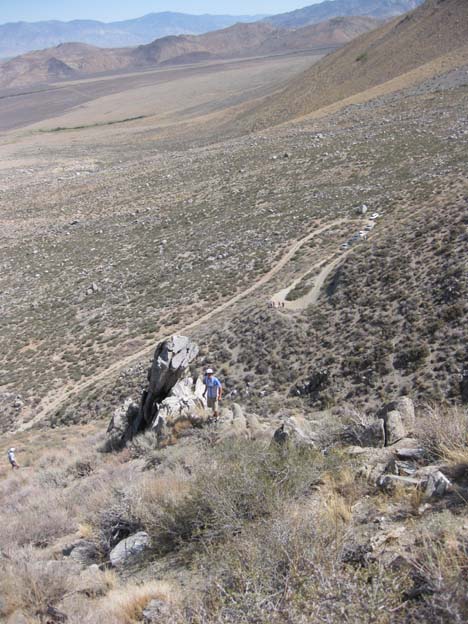
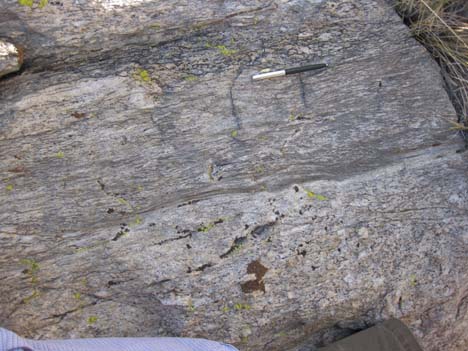
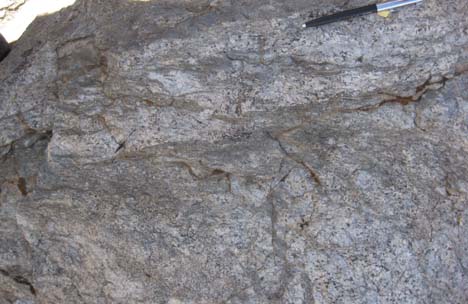
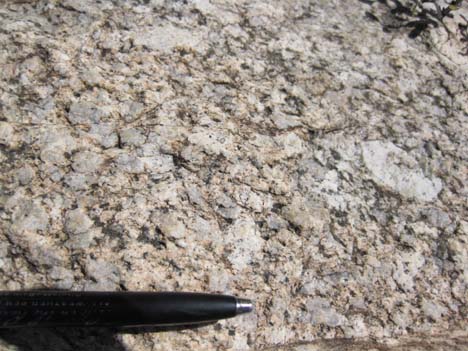
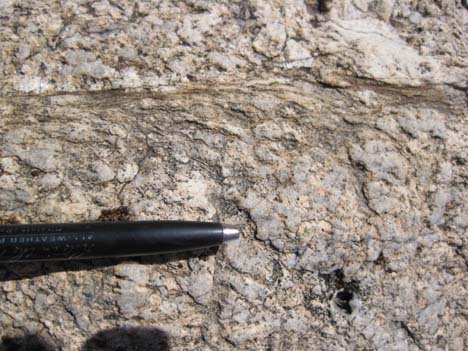
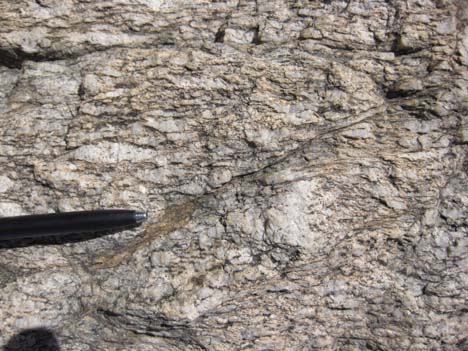
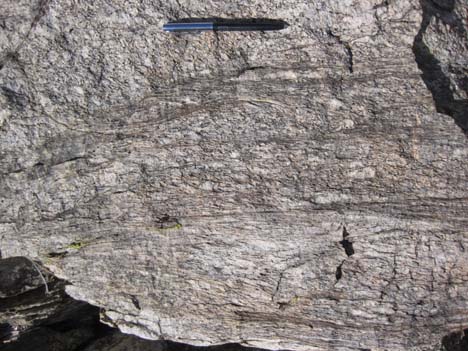
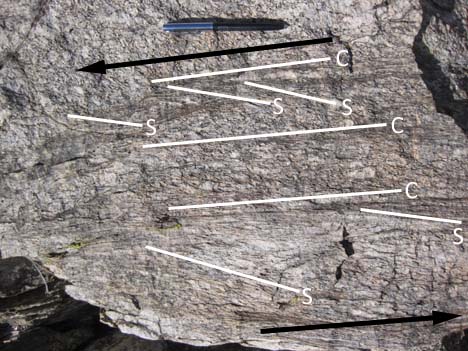
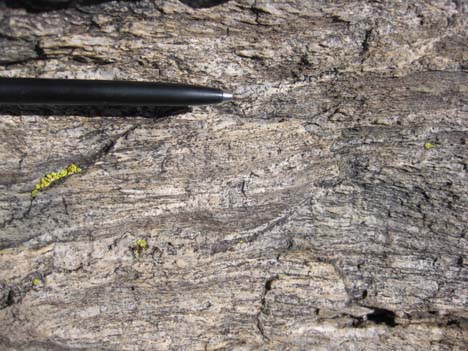
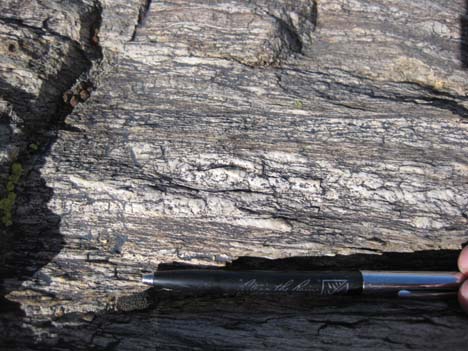
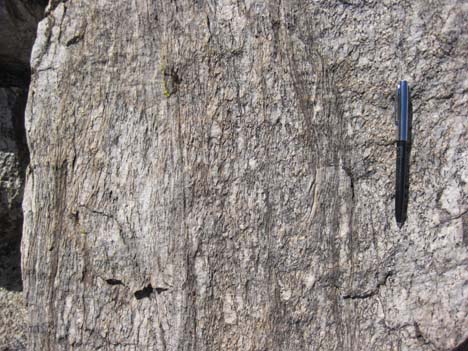
Yay! Mylonites!
(I like the look of the new blog.)
Thanks Kim! I hope to do a lot more structure over here!
Sent from my iPhone